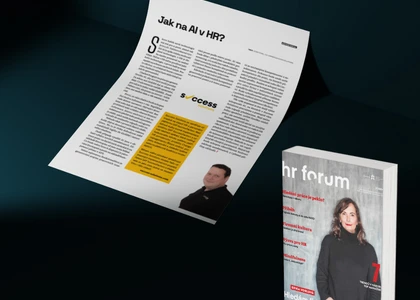How to implement AI in HR?
Nearly every new technology has its pros and cons, and the same goes for AI. While the general use of AI is more a question of the capabilities of the technology, in HR, it's essential to prioritize personal data. Before any technology is used in HR, data protection must be the foremost consideration.

Therefore, many who anticipated a boom in the deployment of chatbots still often wait for their implementation.
A chatbot operates on the principle of generative AI to engage in conversation. It has a data repository containing all HR data. However, it cannot differentiate permissions; for it, it's just one large repository. In other words, it can understand, but only at the level of "this is my personal data, and everything else is foreign to me."
Initially, the first thing the chatbot will be able to tell you is information about yourself. For example, your date of birth, remaining vacation days, or who your superior is, etc. It will also handle general company information, such as which directive an employee should read or whether they can dispose of a yogurt container in mixed waste. However, in the initial stages, it won't know how much vacation time your entire team has left. Further development of logic in the repository and the chatbot itself is required for that.
Other use cases of AI are in the realm of selecting new employees. Filtering positions on career websites based on resumes is already commonplace. What will soon be available is matching resumes and positions based on competencies directly in ATS.
A highly interesting functionality is generating job ad descriptions solely based on position titles. AI will even conduct candidate pre-selection for screening without any human intervention. In theory, one day, the entire selection process could be completed with the help of AI and a single personal interview.
Where AI will likely be most beneficial is in generating required competencies for job positions and comparing them with the current competencies of employees. It will even be able to determine competencies based on positions held in the past or LinkedIn profiles. You will be able to quickly develop a competency model for the entire company in minutes and use it for training, for example. It will evaluate the benefits of courses in terms of increasing competency levels and recommend training to employees.

Everything described above is just a small list of AI capabilities that we are working on at Success Solutions, and we will introduce many more ideas to you in due course. They all have one thing in common: they will undoubtedly make things easier for people, but they won't replace them but instead give you the tools you need.
The future depends on the analysis of all the data you have in your HR systems. In the future, AI will examine all your data and, based on previous experiences, recommend the most suitable candidate(s) for inclusion in the talent pool. It won't be based on evaluation, based on 80 different parameters. Similarly, it will be able to identify future employee departures and their exact causes for their departure.
